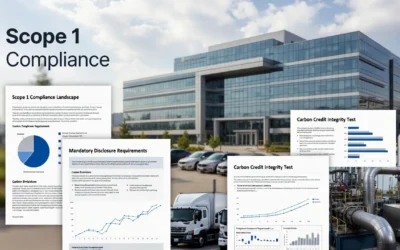Bill Ickes
Navigating High Costs, Project Risk, and the Rise of Verifiable Nature-Based Solutions
For Chief Sustainability Officers and corporate leaders, the mandate is clear: achieve ambitious decarbonization goals. Yet the path forward is clouded by a volatile and complex carbon market. While mechanical Carbon Capture, Utilization, and Storage (CCUS) has been touted as a cornerstone of industrial decarbonization, a clear-eyed analysis of its performance and cost projections reveals a landscape fraught with financial risk and uncertainty.This analysis synthesizes recent market data to forecast the state of the carbon market through 2035, highlighting the economic realities that will shape corporate strategy. More importantly, it presents a proven, scalable, and cost-effective alternative that sidesteps the pitfalls of mega-projects: Direct Air Capture via Plants (DAC-P).
The Hard Realities of Mechanical CCUS: A Look Toward 2035
Recent data from leading energy and policy institutions paint a challenging picture for conventional CCUS. While essential for certain hard-to-abate sectors, its widespread adoption is hampered by three core issues.
- Persistently High Costs and Capital Risk
Mechanical carbon capture is fundamentally expensive. First-generation power plant retrofits like Canada’s Boundary Dam (2014) clocked in at around $80/t of CO2 captured, requiring over $1 billion in capital. While its successor, Petra Nova (2017), demonstrated a cost reduction to ~$65/t, the project was mothballed in 2020 due to poor financial returns.The risk is most evident in mega-projects. Australia’s Gorgon CCS project, initially projected at $70/t, saw costs escalate to between $100 and $222/t due to persistent technical issues and underperformance. For corporations, this translates into unpredictable costs and a high risk of stranded assets. - Modest Learning Rates and Slow Cost Reduction
Unlike the rapid cost declines seen in solar and wind energy, CCUS technology has a modest learning rate. Each facility is a massive, customized engineering project, not a mass-manufactured product. The U.S. Department of Energy projects a potential 25% cost reduction between first-of-a-kind and “Nth-of-a-kind” plants, but this progress is slow. Even optimistic projections for heavy industry (cement, steel) see costs remaining around $70/t by 2035—still above the threshold for profitability under current U.S. 45Q tax credits ($85/t) without additional incentives. - Heavy Reliance on Policy and Subsidies
The economic viability of nearly every major CCUS project hinges on government support. Norway’s early Sleipner and Snøhvit projects were profitable only because of a national carbon tax. Today, U.S. projects rely on the 45Q tax credit and, in some cases, stacking credits like California’s Low Carbon Fuel Standard (LCFS). This policy dependence creates long-term uncertainty for corporations seeking stable, predictable decarbonization pathways.
The Strategic Alternative: Direct Air Capture via Plants (DAC-P)
Given these market realities, where can sustainability leaders find reliable, cost-effective, and scalable carbon removal today? The answer lies in harnessing the planet’s most powerful carbon capture engine: photosynthesis.We call this approach Direct Air Capture via Plants (DAC-P). It is not simply planting trees; it is a scientifically managed system designed for maximum carbon drawdown and permanent sequestration.Nature already captures approximately 120 gigatons of carbon annually—a scale that dwarfs our current mechanical capabilities. Dynamic Carbon Credits (DCC) has operationalized this natural process. In partnership with the Midwestern Research Collaborative, we deploy proprietary, deep-rooted plant varieties across our 800,000-acre network. These crops are bred specifically to pull more CO2 from the atmosphere and store it in their biomass.
From Capture to Permanence: The Biochar Revolution
Capturing carbon is only half the battle; it must be stored durably. DCC utilizes pyrolysis—heating the harvested biomass in a low-oxygen environment—to convert it into biochar. This stable, carbon-rich material locks away the captured CO2 for centuries, preventing its re-release into the atmosphere.
This process is critical for two reasons:
- Permanence:
Unlike raw biomass that decomposes and releases its carbon, biochar creates a verifiable, long-term carbon sink in the soil. - Methane Reduction:
By diverting biomass from landfill or decay, we prevent the emission of methane, a greenhouse gas with over 28 times the warming potential of CO2 over a 100-year period.
Furthermore, applying biochar to farmland improves soil health, enhances water retention, and boosts nutrient efficiency, creating tangible benefits for farmers and agricultural communities.
A Clear-Eyed Comparison: DCC vs. The Market
When placed side-by-side, the strategic advantages of DCC’s DAC-P and biochar solution become undeniable for any corporate sustainability leader.
Methods of Capturing Carbon
The Executive’s Playbook for a Resilient Carbon Strategy
The carbon market of 2035 will reward those who make smart, de-risked decisions today. Relying solely on the promise of future, cheaper mechanical CCUS is a high-stakes gamble.
“Fortune 500 leaders are no longer just buying offsets; they are building resilient, diversified carbon removal portfolios,” notes Beau Parmenter, a global commerce advisor. “The most intelligent strategies are those that lock in verifiable, high-integrity removal at a predictable cost. Solutions that combine permanence with tangible co-benefits for communities and ecosystems are setting the new standard for corporate leadership.”
By integrating Dynamic Carbon Credits into your sustainability strategy, you are not merely offsetting emissions. You are investing in a cost-effective, scientifically validated, and permanent carbon removal solution that is available at scale now. Our rigorous, third-party verified chain of custody ensures every credit meets the highest standards of additionality and transparency, providing the assurance needed for credible ESG reporting.
The prediction is clear: the future of the voluntary carbon market belongs to solutions that are not only effective but also economically sound and environmentally holistic.
Take the next step toward a resilient and impactful sustainability strategy.
Offset your footprint now.






